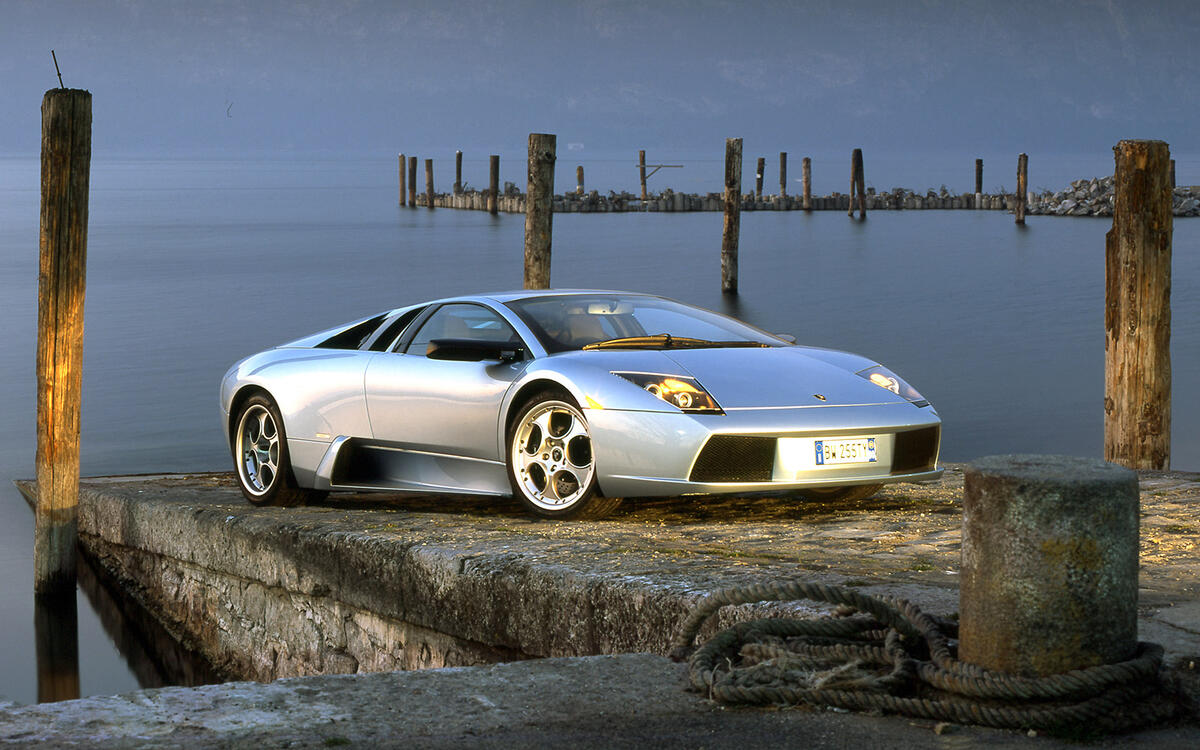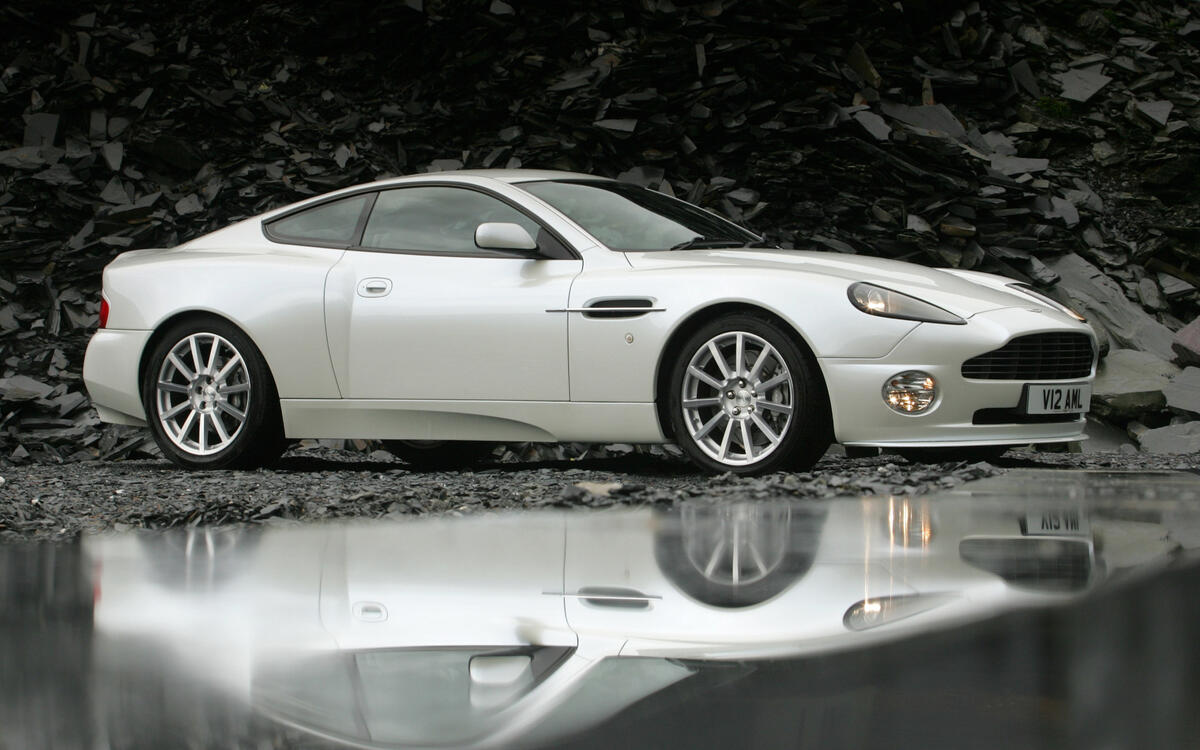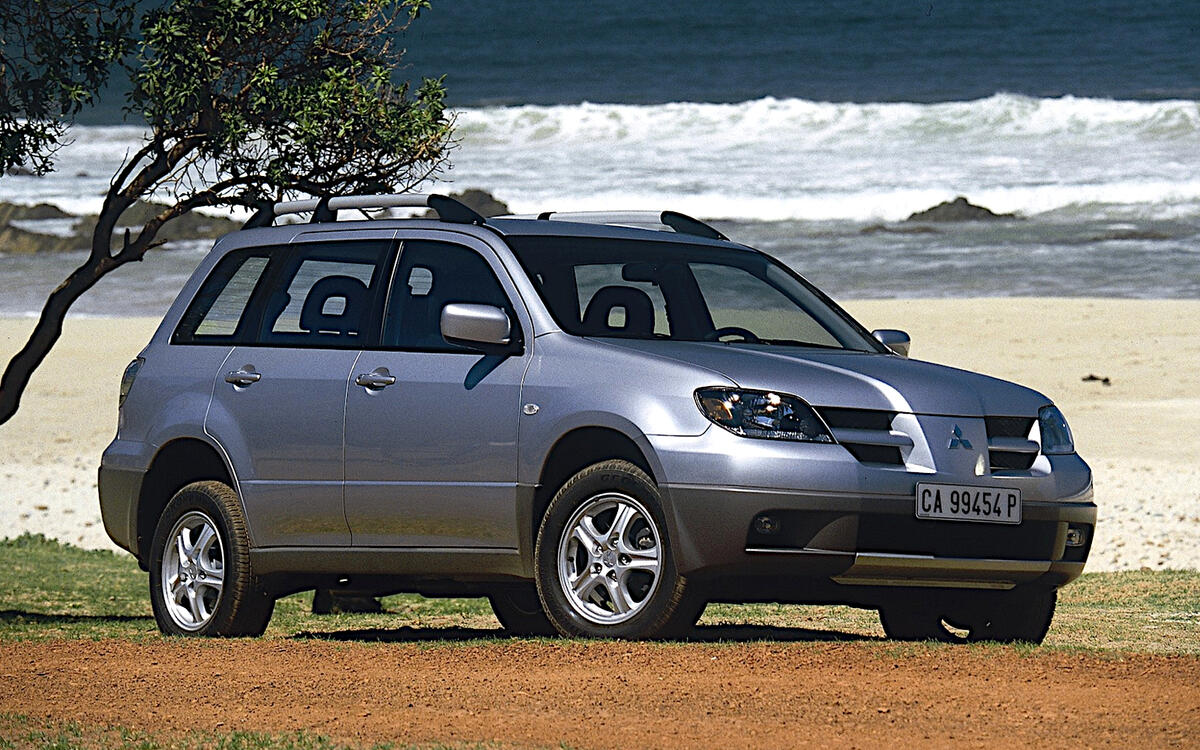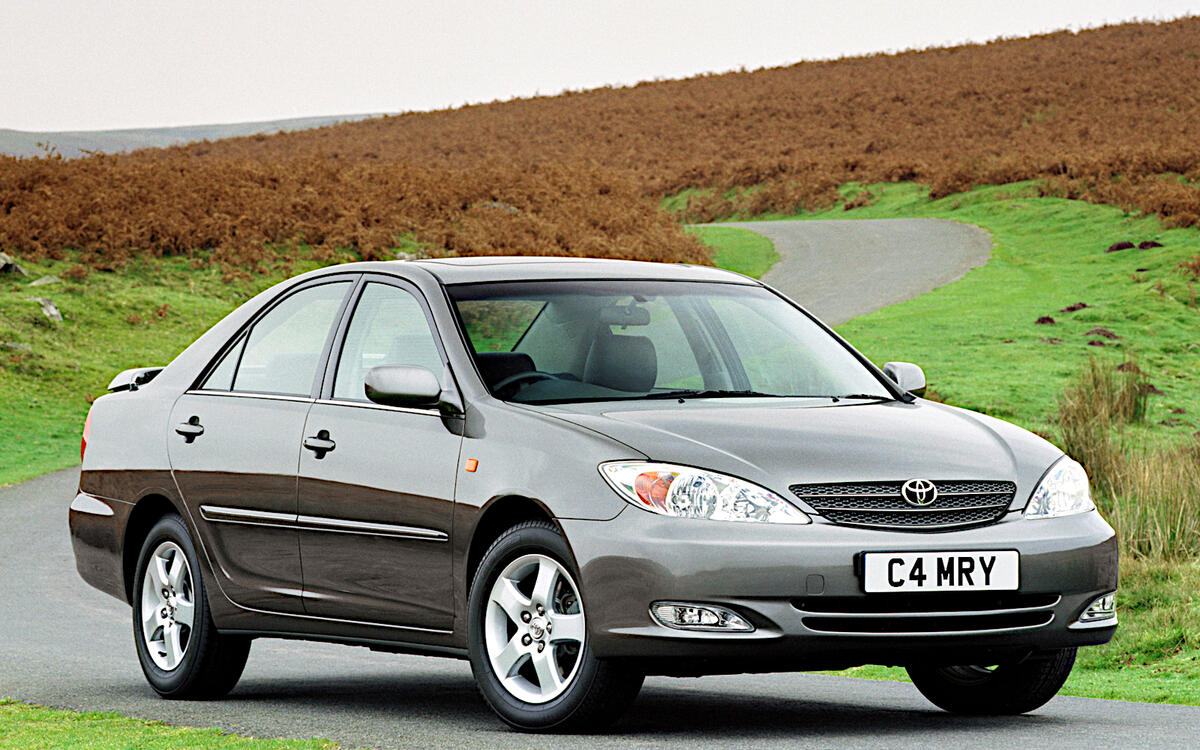 Slide of
Slide of
2001 was the year when everyone could finally agree, after twelve months of intense discussion, that we were definitely in the 21st century.
That year manufacturers around the world put a remarkable number of new cars on the market. MG Rover was particularly busy as it tried to stave off inevitable bankruptcy, Renault brought out three of the most extraordinary models in its history, and the Big Three North American manufacturers tried, as always, to find new corners of the market to exploit.
And that was just the start of it. Read on for a detailed explanation of why 2001 was such a bumper year:
 Slide of
Slide of
Aston Martin V12 Vanquish
The last Aston to be built at Aston’s old factory at Newport Pagnell was based on an extruded aluminium chassis with carbonfibre reinforcement. Its 5.9-litre V12 engine was derived from Ford’s 3.0-litre V6 and produced 460bhp at first. The Vanquish S, introduced in 2004, had several changes including a power increase to 520bhp.
The V12 Vanquish appeared in Die Another Day, the eighth of 13 James Bond films so far (including the yet to be released No Time To Die) to feature one or more Aston Martins.
 Slide of
Slide of
BMW 7 Series
The fourth-generation 7 Series was the first BMW to feature the brand’s new ‘flame-surfaced’ design language and the iDrive infotainment system. Both were controversial at the time, on the grounds of over-styling and over-complication respectively.
Nearly every example had a petrol or diesel engine, with capacities ranging from 3.0 to 6.0 litres. A very special version with long-wheelbase bodywork, available only to lease, had a V12 engine capable of running on petrol or hydrogen. For obvious reasons, it was known as the Hydrogen 7.
 Slide of
Slide of
Buick Rendezvous
In 2021, Buick’s entire range consists of nothing but crossovers. The very first example was the Rendezvous, launched in 2001 for the 2002 model year.
It had seven seats, a V6 engine of between 3.4 and 3.6 litres and a choice of front- or four-wheel drive. The styling was perhaps as not as elegant as it could be, but it was better than that of its older and less successful corporate cousin, the somewhat infamous Pontiac Aztek.
 Slide of
Slide of
Buick Sail
Buick’s version of the Corsa, sold elsewhere with Chevrolet, Opel and Vauxhall branding, went into production in China in 2001. It was available first as a four-door saloon and later as a five-door estate.
In 2005, the Sail was rebranded as a Chevrolet, following GM’s introduction of that name to the Chinese market.
 Slide of
Slide of
Cadillac Escalade EXT
Even today when it’s possible to buy SUVs built by Bentley and Rolls-Royce, it still seems incredible that GM’s luxury brand once produced a pickup truck. But it did.
The EXT was the pickup version of the second-generation Cadillac Escalade SUV. Like the Chevrolet Avalanche and other GM pickups, it had a Convert-a-Cab system which extended the pickup bed into the cabin. Despite this, the EXT was one of the top ten worst-selling vehicles in the US when the second-generation EXT was discontinued in 2013.
 Slide of
Slide of
Chevrolet Avalanche
The first generation of this full-size pickup truck was based on the same platform as the Suburban, Tahoe and Cadillac Escalade SUVs, among other GM products. Unusually for a Chevrolet pickup, there was no GMC-badged equivalent.
It was replaced in 2007 by a new version which lasted until 2013. Chevrolet has not used the Avalanche name since then.
 Slide of
Slide of
Chevrolet TrailBlazer
GM first used the TrailBlazer name for a model in the S10 SUV range. The first ‘real’ TrailBlazer was also an SUV, fitted with either a 4.2-litre straight-six engine or a V8 of either 5.3 or 6.0 litres. Drive went to the rear wheels or, optionally, all four.
The name was adjusted sightly to Trailblazer for the second generation. The current, third, version bears no resemblance to the previous two. It’s a crossover with small three- or four-cylinder engines, and is so popular that Chevrolet is having difficulty building enough to satisfy demand.
 Slide of
Slide of
Citroën C5
The 2001 C5 was the first Citroën to use the now familiar ‘C plus a number’ naming system since the C4 and C6 of 1928. Engine sizes ranged from 1.8 to 3.0 litres, and the car had the latest version of the hydropneumatic suspension for which Citroën was once so famous.
The C5 was given a facelift in 2004 and replaced by a more sharply-styled all-new model in early 2008.
 Slide of
Slide of
Fiat Stilo
The Stilo was the single replacement for the mechanically identical three-door Bravo and five-door Brava hatchbacks. It placed third in the 2002 European Car of the Year award, just one point behind the Renault Laguna but 43 adrift of the winning Peugeot 307.
As well as a hatchback, the Stilo was offered as an estate called MultiWagon. An Abarth version with a 170bhp 2.4-litre five-cylinder engine was further developed into a 2005 special edition named after multiple F1 World Champion Michael Schumacher.
 Slide of
Slide of
Ford Thunderbird
The eleventh and possibly final iteration of the Thunderbird was a retro model, similar in concept to the Chrysler PT Cruiser, MINI, Plymouth Prowler and Volkswagen Beetle. Like the original car, it was a two-seat convertible, in this case powered by a 252bhp 3.9-litre version of the Jaguar AJ-V8 engine.
Like the Aston Martin V12 Vanquish mentioned earlier, the Thunderbird made an appearance in the James Bond film Die Another Day, and again two years later (heavily disguised as the pink, six-wheeled FAB1) in the 2004 movie Thunderbirds. Despite all this publicity, it remained in production for only four years.
 Slide of
Slide of
GMC Envoy
The 2001 Envoy was the second GMC SUV to bear that name. It could be ordered with a 4.2-litre straight-six engine or a 5.3-litre V8. The latter was sometimes offered with Displacement on Demand, a system which shut down some of the cylinders when minimal power was required. Variants included the long-wheelbase XL and a cross between an SUV and a pickup called the XUV.
Production ended in 2009. There has been speculation that an Envoy crossover will be introduced at some point, but that it will carry Buick branding.
 Slide of
Slide of
G-Wiz
The electric city car sold in the UK as the G-Wiz was in fact the REVAi built by the Reva Electric Car Company of India. It was officially classed as a heavy quadricycle rather than a ‘real’ car.
Though undeniably useful in its way, the G-Wiz was criticised for its looks and, more seriously, its questionable ability to protect occupants in a crash.
 Slide of
Slide of
Honda Civic Hybrid
Also known as the Civic IMA, this was Honda’s first hybrid model after the more specialised first-generation Insight. Unusually, though not uniquely, for 2001, it was powered by both a 1.3-litre petrol engine (with start-stop) and an electric motor.
The official combined fuel economy figure was 57.6mpg, only slightly better than the 56.5mpg of the Civic diesel. It was probably helped by the gearing which, unlike that of many other Hondas at the time, was extraordinarily high.
 Slide of
Slide of
Honda Jazz
Also known as the Fit, the first-generation Jazz was a supermini offered with a variety of four-cylinder engines ranging in capacity from 1.2 to 1.5 litres. Even Honda officials were grudgingly prepared to admit after the fact that the ride quality was “not so good”, but in the car’s favour it had a remarkable amount of space for passengers and luggage.
The Jazz is now in its fourth generation, having retained the concept and to some extent the appearance of the original model.
 Slide of
Slide of
Honda Mobilio
On sale in Japan from late December 2001, the Mobilio was a compact MPV which could seat seven passengers despite being only nine feet long. Available with two 1.5-litre petrol engines with substantially different power outputs, it was also sold with either front- or four-wheel drive.
Production ended in 2008, but a new Mobilio was introduced six years later.
 Slide of
Slide of
Hyundai Matrix
The vehicle sold in Europe as the Matrix was known in other markets as the Lavita or, in Australia, the Elantra LaVita. It was based on the third-generation Elantra but looked very different – the Pininfarina styling included a very high roof and deep side windows.
There was a choice of petrol engines, and European customers could also specify three- or four-cylinder turbodiesels, at a time when diesel passenger vehicles could not be sold in the car’s home market of South Korea.
 Slide of
Slide of
Hyundai Terracan
Marketed as more of a workhorse than the Santa Fe and Sorento, Hyundai’s other SUVs of the period, the Terracan was in fact quite refined, with good soundproofing and excellent ride quality. In Europe, the engines available were a 3.5-litre petrol V6 and a more economical, though less powerful, 2.9-litre four-cylinder turbodiesel.
Production came to an end in South Korea and India in 2007, but continued in China until 2011.
 Slide of
Slide of
Isuzu Axiom
The Axiom replaced the second-generation Trooper SUV. It was built, mainly for the US market, at a factory in Lafayette, Indiana now known as Subaru of Indiana Automotive.
But not for long. The Axiom did not sell well, and was axed in 2004. The Lafayette plant switched to building Subarus, and within a few years Isuzu had withdrawn completely from the US.
 Slide of
Slide of
Jaguar X-Type
In the days before platform sharing became widely accepted, the X-Type suffered in the public eye from being closely related to the Ford Mondeo. Innovations included a diesel engine – the first fitted to any Jaguar – and a 2.0-litre model which sold for just under £20,000, an incredibly low figure for the marque at that time.
Early models had four-wheel drive, though front-wheel drive would be introduced later. As an alternative to the saloon body shape, customers could have a very elegant estate; the Queen owned one of these. None of this was enough to prevent Jaguar from abandoning the project in 2009.
 Slide of
Slide of
Jeep Cherokee/Liberty
Sold in the US as the Liberty and elsewhere as the latest in a long line of Cherokees, this 2001 SUV featured such unJeeplike features as rack-and-pinion steering and independent front suspension.
2.4-litre four-cylinder and 3.7-litre V6 engines were offered, along with a 2.8-litre turbodiesel supplied by Italian company VM Motori. The next-generation version, with a boxier and less bug-eyed appearance, arrived in 2007.
 Slide of
Slide of
Lamborghini Murciélago
Named after a bull which was in turn named after a bat, the Murciélago was the first Lamborghini to be designed after the company came under Audi’s ownership. It was also the last to be built with Lamborghini’s famous V12 engine of 1963. The Murciélago's successor, the Aventador, used an all-new design for its V12.
In the Murciélago, the V12 was available first in 6.2-litre form and later expanded to 6.5 litres. As fitted to the LP670-4 SuperVeloce, it produced over 660bhp. The car was replaced by the Aventador in 2011.
 Slide of
Slide of
Lincoln Blackwood
The Blackwood was Ford’s rival to GM’s luxury pickup truck, the Cadillac Escalade EXT mentioned previously. Though undoubtedly well-equipped, it was so unpopular that production was abandoned after little more than a year.
In 2005, Lincoln tried again with the Mark LT. This wasn’t a big seller either, but it survived through two generations until 2014.
 Slide of
Slide of
Mercedes-Benz SL-Class
This two-seat roadster was the fifth model in the SL-Class series, and remained in production for just over ten years.
The top engine in the range was a twin-turbo 6.0-litre V12 which produced 660bhp in the mighty SL 65 AMG Black Series of 2008, which cost £116,625 at launch. “Brutal looks and performance, but difficult to justify the price,” we said.
 Slide of
Slide of
MG Express
In the early years of the century, MG Rover was trying to find ways of extracting more value from existing cars. The MG Express was perhaps the strangest example. It was the van equivalent of the MG ZR, which was itself derived from the Rover 25 hatchback.
The most powerful version had a 160bhp engine. With fewer windows and no rear seats, it was probably quicker than the ZR, but as a commercial vehicle it did not have official performance figures. Only 317 Express vans of any sort were built, and 69 are still registered for use on UK roads.
 Slide of
Slide of
MG ZR
The ZR was the sporty version of the Rover 25 supermini, a renamed version of the 1995 Rover 200. The handling, enhanced by sports suspension, was generally agreed to be the car’s best feature, though other aspects came in for criticism.
Still, it was quite popular among young buyers, mostly thanks to discounts and free insurance offers. Production came to an end when, after years of speculation that this would happen sooner or later, MG Rover collapsed into a financial sinkhole in 2005.
 Slide of
Slide of
MG ZS
Echoing the status of the MG ZR, the larger ZS was MG’s sporty version of the Rover 45, formerly known as the Rover 400. Several engines were available, by far the most impressive being a 175bhp 2.5-litre V6.
But straightline speed was not what the ZS was all about. The important thing was that it handled magnificently. Very few front-wheel drive performance cars before or since have been able to match it.
 Slide of
Slide of
MG ZT
This was the MG equivalent of the Rover 75, launched in 1998. It was available both as a slightly staid-looking saloon and as a much more elegant estate. The most surprising variant was the ZT 260. While all others were front-wheel drive and had four-cylinder or V6 Rover K-Series engines, the 260 had a Ford 4.6-litre V8 (borrowed from the Mustang) driving the rear wheels.
As with the MG models mentioned earlier, production came to an abrupt halt in 2005 when parent company MG Rover ran out of money.
 Slide of
Slide of
Mitsubishi Outlander
Although it made its debut in the UK and US in 2003, the Outlander was in fact a version of the Mitsubishi Airtrek introduced in Japan two years previously. It was Mitsubishi’s first crossover, and there was no diesel version, which didn’t help sales in Europe.
There was, however, a DualFuel variant which could run on petrol or LPG. It cost £1000 more, but it was eligible for the UK Government’s PowerShift grant and exempt from the London congestion charge.
 Slide of
Slide of
Perodua Kelisa
The Kelisa was a city car built and sold by the Malaysian company Perusahaan Otomobil Kedua, usually abbreviated to Perodua. Like all the firm’s products at that time, it was a locally-built and rebadged Daihatsu, in this case the fifth-generation Mira.
In entry-level EX form, the Kelisa had the distinction of being the cheapest car on sale in the UK.
 Slide of
Slide of
Peugeot 307
The 307 easily won the 2002 European Car of the Year award, comfortably outscoring the Renault Laguna and Fiat Stilo. It had been launched the previous year, and was available in several forms including saloon, hatchback, estate and the slightly MPV-like SW.
There was also a coupe-cabriolet, a body style briefly popular among manufacturers. Oddly, Peugeot used the 307 CC as the basis for its World Rally Championship campaign, though the competition vehicle did not have a folding roof. The 307 WRC was not a patch on the 206 WRC it replaced, and failed to win a championship title.
 Slide of
Slide of
Renault Avantime
2001 was the wrong year to criticise Renault for unadventurous design. One of its more unusual products, largely the work of Matra but styled by Renault’s Patrick Le Quément, was an answer to the rarely asked question, “What would a cross between a coupe and an MPV be like?”
The result was, to say the least, distinctive. The one-box body suggested forward motion no matter what the car was doing, and the double-hinged doors were innovative. Less positively, you had to take a remote control out of a drawer in the centre of the dashboard just to switch the radio on or off.
 Slide of
Slide of
Renault Clio V6 Renaultsport
Although it looked similar to other second-generation Clios, the V6 was radically different under the skin. There were no rear seats because the back half was dominated by a 3.0-litre engine otherwise found in the Renault Laguna.
The V6 was quick, but as several people found to their cost its handling was pretty much what you would expect of a short-wheelbase car with a tall, heavy engine mounted between the rear wheels. Journalists at the UK press launch of the Phase 2 version, introduced in 2003, were forbidden from driving it quickly round corners.
 Slide of
Slide of
Renault Vel Satis
The Vel Satis provided further support for the old idea that large French executive cars do not sell well outside France. Author Stephen Bayley has been widely quoted as saying, paradoxically, that it wasn’t quite ugly enough to succeed.
Be that as it may, the Vel Satis was one of the earliest cars to be awarded the full five stars for adult occupant protection by EuroNCAP. The very first was the Renault Laguna, which was based on the same platform.
 Slide of
Slide of
Saturn Vue
The Vue crossover was by some margin the earliest GM vehicle based on the Theta platform which was also used for the Vauxhall/Opel Antara, among others. It was offered with four-cylinder petrol engines (sometimes as part of a hybrid powertrain) or a V6 of up to 3.5 litres.
The second-generation Vue was introduced in 2008 but was discontinued shortly afterwards when GM shut down the Saturn brand.
 Slide of
Slide of
Skoda Superb
Skoda revived a model name it had last used in 1949 for the large family car it introduced 52 years later. The new Superb was notable for offering outstanding amounts of room for both passengers and luggage at a very low price. It was also comfortable and well-built, and was even supplied with an umbrella.
Not without reservations, EuroNCAP awarded the Superb four out of five stars for adult occupant protection, but refused to award any at all for pedestrian protection, describing the car as “abysmal” in this respect. Later generations have performed outstandingly better in crash tests.
 Slide of
Slide of
SsangYong Rexton
Styled by Italdesign, the Rexton was a mid-sized SUV available with several diesel engines and a 3.2-litre petrol V6, all of them built under licence from Mercedes-Benz.
The first-generation Rexton had a long life. After two major upgrades, it was finally replaced by the current model in 2017.
 Slide of
Slide of
Toyota Camry
Codenamed XV30, the 2001 Camry saloon was the fifth-generation model designed for international markets rather than the local Japanese one. It was offered with a variety of four- and six-cylinder petrol engines and a choice of manual or automatic transmissions and front- or four-wheel drive.
The Camry was assembled in many factories around the world, including the Toyota Motor Manufacturing Kentucky plant in the US, where it was exceptionally popular.
 Slide of
Slide of
Toyota Highlander
Strictly speaking, the Highlander was launched on the Japanese market in late 2000, but it was known there (and in Australia) as the Kluger. With the Highlander nameplate, this mid-sized crossover, based on the same platform as the contemporary Camry, first went on sale in early 2001.
Unlike other crossovers of the period, the Highlander had a unibody construction rather than a separate body and frame. At first, it was offered with a 2.4-litre four-cylinder petrol engine or a 3.0-litre V6, but a more powerful 3.3-litre V6 was introduced later.
Join us as turn the clock back and take a look at the important new cars from 20 years ago
Advertisement















































































